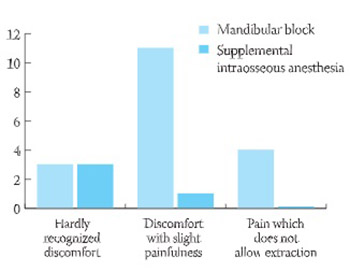The efficacy of supplemental intraosseous anesthesia after insufficient mandibular block
DOI:
https://doi.org/10.17305/bjbms.2005.3336Keywords:
intraosseous, anesthesia, supplementalAbstract
It is a well-known scientific fact that only a small percentage of infiltration of inferior alveolar nerve is clinically proven to be efficient. The objective of this study was to determine the anesthetic efficacy of supplemental intraosseous injection, used after the insufficient classical mandibular block that didn't provide deep pulp anesthesia of mandibular molar planed for extraction. The experimental teeth consisted of 98 mandibular molars with clinical indication for extraction. Based on the history of disease, we indicated the extraction of the tooth. After that each tooth was tested with a electric pulp tester P1. We tested the pulp vitality and precisely determined the level of vitality. After that, each patient received classical mandibular block, and the pulp vitality was tested again. If the pulp tester indicated negative vitality for the certain mandibular molar, and the patient didn't complain about pain or discomfort during the extraction, the molar was extracted and the result was added to anesthetic success rate for the classical mandibular block. If, five minutes after receiving the mandibular block, the pulp tester indicated positive vitality (parameters of vitality) or the patient complained about pain or discomfort (parameters of pain and discomfort), we used the Stabident intraosseous anesthesia system. Three minutes after the application of supplemental intraosseous injection the molar was tested with the pulp tester again. The anesthetic solution used in both anesthetic techniques is lidocaine with 1:100.000 epinephrine. The results of this study indicate that the anesthetic efficacy of the mandibular block is 74.5%, and that supplemental intraosseous anesthesia, applied after the insufficient mandibular block, provides pulpal anesthesia in 94.9% of mandibular molars. The difference between anesthetic efficacy of the classical mandibular block and anesthetic efficacy of the supplemental intraosseous anesthesia, applied after the insufficient mandibular block, is obvious.
Citations
Downloads

Downloads
Published
Issue
Section
Categories
How to Cite
Accepted 2018-03-11
Published 2005-02-20









